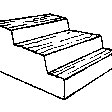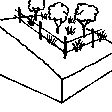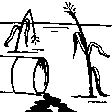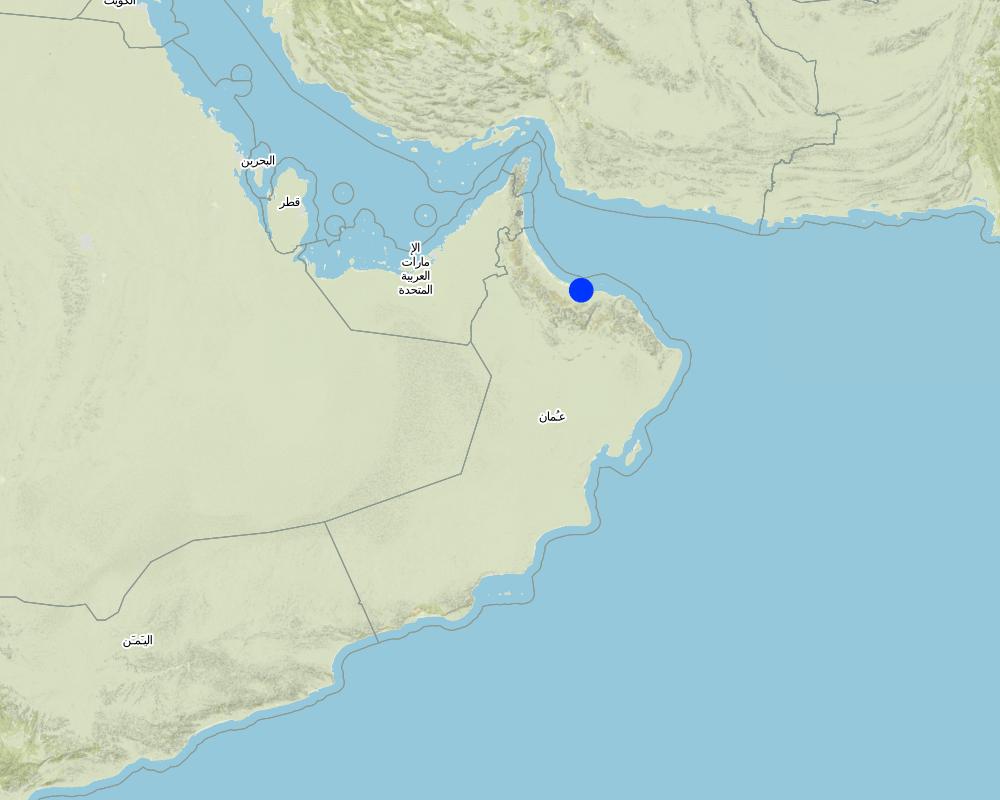Alfalfa under flood irrigation [Oman]
- Creation:
- Update:
- Compiler: Badria Alhosni
- Editor: –
- Reviewer: David Streiff
إستخدام تقنية الغمر في زراعة محصول البرسيم
technologies_1311 - Oman
View sections
Expand all Collapse all1. General information
1.2 Contact details of resource persons and institutions involved in the assessment and documentation of the Technology
SLM specialist:
SLM specialist:
SLM specialist:
SLM specialist:
SLM specialist:
SLM specialist:
AL Abri Fatima
MOAF
Oman
Name of the institution(s) which facilitated the documentation/ evaluation of the Technology (if relevant)
Test institution (TI) - AlbaniaName of the institution(s) which facilitated the documentation/ evaluation of the Technology (if relevant)
Sultan Qaboos University (SQU) - Oman1.3 Conditions regarding the use of data documented through WOCAT
When were the data compiled (in the field)?
17/12/2015
The compiler and key resource person(s) accept the conditions regarding the use of data documented through WOCAT:
Yes
2. Description of the SLM Technology
2.1 Short description of the Technology
Definition of the Technology:
Alfalfa grown for fodder using flood irrigation from groundwater
2.2 Detailed description of the Technology
Description:
The technology involves growing alfalfa using irrigation from a well with salinity 5.4 dS/m. The total area is 10 faddan of which about a quater faddan is planted with sorghum and sesame. The farm has been cultivated for over 40 years. Alfalfa survives for 5 years at present but it used to sustain for over 12 years before. Showing that duration of harvesting age has reduced mainly due to increasing in the soil salinity, wich is greatly affected by subsequent increase in water salinity.
Purpose of the Technology: Alfalfa is grown for fodder production that is sold in the markets to earn income for supporting livelihoods of households.
Establishment / maintenance activities and inputs: The land is prepared using tractors. Two cycles of plowing and harrowing are undertaken before sowing the grass. Seed are broadcasted after proper seedbed preparation. The land is irrigated immediately after planting. The field is fertilized by manure mixture with Urea.
Natural / human environment: The land is flat with slope ranging from 0-2%. The soils are deep mostly sandy and sandy loam
2.5 Country/ region/ locations where the Technology has been applied and which are covered by this assessment
Country:
Oman
Region/ State/ Province:
Al Batinah South
Further specification of location:
AL Mussanha
Map
×2.6 Date of implementation
If precise year is not known, indicate approximate date:
- more than 50 years ago (traditional)
2.7 Introduction of the Technology
Specify how the Technology was introduced:
- as part of a traditional system (> 50 years)
3. Classification of the SLM Technology
3.1 Main purpose(s) of the Technology
- improve production
- create beneficial economic impact
3.2 Current land use type(s) where the Technology is applied

Cropland
- Perennial (non-woody) cropping
Comments:
Major land use problems (compiler’s opinion): Problems in Cropland, alfalfa production is decreasing because of increasing in soil and water salinity
Major land use problems (land users’ perception): productivity is declning
Future (final) land use (after implementation of SLM Technology): Cropland: Cp: Perennial (non-woody) cropping
If land use has changed due to the implementation of the Technology, indicate land use before implementation of the Technology:
Cropland: Cp: Perennial (non-woody) cropping
3.3 Further information about land use
Water supply for the land on which the Technology is applied:
- full irrigation
Number of growing seasons per year:
- 2
Specify:
Longest growing period in days: 45; Longest growing period from month to month: October to Mid November
Livestock density (if relevant):
1-10 LU /km2
3.4 SLM group to which the Technology belongs
- irrigation management (incl. water supply, drainage)
3.5 Spread of the Technology
Specify the spread of the Technology:
- evenly spread over an area
If the Technology is evenly spread over an area, indicate approximate area covered:
- 1-10 km2
Comments:
Total area covered by the SLM Technology is 4.6 km2.
3.6 SLM measures comprising the Technology

agronomic measures
- A1: Vegetation/ soil cover
- A2: Organic matter/ soil fertility

vegetative measures
- V2: Grasses and perennial herbaceous plants

structural measures
- S11: Others

management measures
- M2: Change of management/ intensity level
Comments:
Type of agronomic measures: better crop cover, early planting, manure / compost / residues, mineral (inorganic) fertilizers, deep tillage / double digging
Type of vegetative measures: scattered / dispersed
3.7 Main types of land degradation addressed by the Technology

chemical soil deterioration
- Cn: fertility decline and reduced organic matter content (not caused by erosion)
- Cs: salinization/ alkalinization
Comments:
Secondary types of degradation addressed: Cn: fertility decline and reduced organic matter content
Main causes of degradation: crop management (annual, perennial, tree/shrub), droughts, population pressure
Secondary causes of degradation: soil management, over abstraction / excessive withdrawal of water (for irrigation, industry, etc.), change in temperature, change of seasonal rainfall, labour availability
3.8 Prevention, reduction, or restoration of land degradation
Specify the goal of the Technology with regard to land degradation:
- reduce land degradation
Comments:
Secondary goals: prevention of land degradation, rehabilitation / reclamation of denuded land
4. Technical specifications, implementation activities, inputs, and costs
4.2 Technical specifications/ explanations of technical drawing
Technical knowledge required for field staff / advisors: moderate
Technical knowledge required for land users: high
Main technical functions: improvement of ground cover
Secondary technical functions: increase of groundwater level / recharge of groundwater
Better crop cover
Material/ species: alfalfa
Quantity/ density: 10000
Remarks: broadcast
Early planting
Material/ species: first planting in October, second planting Feburary
Remarks: broadcast
Scattered / dispersed
Vegetative material: G : grass
Perennial crops species: Alfalfa
Slope (which determines the spacing indicated above): 0-2%
Layout change according to natural and human environment: field orientation
4.3 General information regarding the calculation of inputs and costs
other/ national currency (specify):
Omani Rial
Indicate exchange rate from USD to local currency (if relevant): 1 USD =:
0.384
4.4 Establishment activities
| Activity | Type of measure | Timing | |
|---|---|---|---|
| 1. | Labour |
4.5 Costs and inputs needed for establishment
| Specify input | Unit | Quantity | Costs per Unit | Total costs per input | % of costs borne by land users | |
|---|---|---|---|---|---|---|
| Labour | Labour | ha | 1.0 | 220.0 | 220.0 | 100.0 |
| Plant material | Seeds | ha | 1.0 | 300.0 | 300.0 | 100.0 |
| Other | Electrcity | ha | 1.0 | 80.0 | 80.0 | 100.0 |
| Total costs for establishment of the Technology | 600.0 | |||||
4.6 Maintenance/ recurrent activities
| Activity | Type of measure | Timing/ frequency | |
|---|---|---|---|
| 1. | Cultivation and weeding | Agronomic | twice |
4.8 Most important factors affecting the costs
Describe the most determinate factors affecting the costs:
Labour and fertilzer, pestside
5. Natural and human environment
5.1 Climate
Annual rainfall
- < 250 mm
- 251-500 mm
- 501-750 mm
- 751-1,000 mm
- 1,001-1,500 mm
- 1,501-2,000 mm
- 2,001-3,000 mm
- 3,001-4,000 mm
- > 4,000 mm
Agro-climatic zone
- arid
Thermal climate class: subtropics
5.2 Topography
Slopes on average:
- flat (0-2%)
- gentle (3-5%)
- moderate (6-10%)
- rolling (11-15%)
- hilly (16-30%)
- steep (31-60%)
- very steep (>60%)
Landforms:
- plateau/plains
- ridges
- mountain slopes
- hill slopes
- footslopes
- valley floors
Altitudinal zone:
- 0-100 m a.s.l.
- 101-500 m a.s.l.
- 501-1,000 m a.s.l.
- 1,001-1,500 m a.s.l.
- 1,501-2,000 m a.s.l.
- 2,001-2,500 m a.s.l.
- 2,501-3,000 m a.s.l.
- 3,001-4,000 m a.s.l.
- > 4,000 m a.s.l.
5.3 Soils
Soil depth on average:
- very shallow (0-20 cm)
- shallow (21-50 cm)
- moderately deep (51-80 cm)
- deep (81-120 cm)
- very deep (> 120 cm)
Soil texture (topsoil):
- coarse/ light (sandy)
- medium (loamy, silty)
Topsoil organic matter:
- low (<1%)
If available, attach full soil description or specify the available information, e.g. soil type, soil PH/ acidity, Cation Exchange Capacity, nitrogen, salinity etc.
Soil fertility is low
Soil drainage / infiltration is good
Soil water storage capacity is low
5.4 Water availability and quality
Ground water table:
> 50 m
Availability of surface water:
poor/ none
Water quality (untreated):
for agricultural use only (irrigation)
5.5 Biodiversity
Species diversity:
- low
5.6 Characteristics of land users applying the Technology
Market orientation of production system:
- mixed (subsistence/ commercial
Off-farm income:
- > 50% of all income
Relative level of wealth:
- average
Individuals or groups:
- individual/ household
Gender:
- men
Indicate other relevant characteristics of the land users:
Land users applying the Technology are mainly common / average land users
Population density: 50-100 persons/km2
Annual population growth: 1% - 2%
5.7 Average area of land owned or leased by land users applying the Technology
- < 0.5 ha
- 0.5-1 ha
- 1-2 ha
- 2-5 ha
- 5-15 ha
- 15-50 ha
- 50-100 ha
- 100-500 ha
- 500-1,000 ha
- 1,000-10,000 ha
- > 10,000 ha
Is this considered small-, medium- or large-scale (referring to local context)?
- small-scale
5.8 Land ownership, land use rights, and water use rights
Land use rights:
- individual
Water use rights:
- individual
5.9 Access to services and infrastructure
health:
- poor
- moderate
- good
education:
- poor
- moderate
- good
technical assistance:
- poor
- moderate
- good
employment (e.g. off-farm):
- poor
- moderate
- good
markets:
- poor
- moderate
- good
energy:
- poor
- moderate
- good
roads and transport:
- poor
- moderate
- good
6. Impacts and concluding statements
6.1 On-site impacts the Technology has shown
Socio-economic impacts
Production
fodder production
fodder quality
animal production
Water availability and quality
drinking water availability
drinking water quality
water availability for livestock
water quality for livestock
irrigation water availability
irrigation water quality
demand for irrigation water
Income and costs
farm income
Socio-cultural impacts
food security/ self-sufficiency
livelihood and human well-being
Comments/ specify:
The land user continues to grow alfalfa for the relatively better income he gets from the farm
Ecological impacts
Water cycle/ runoff
water quantity
water quality
evaporation
Soil
soil moisture
soil crusting/ sealing
soil compaction
salinity
6.3 Exposure and sensitivity of the Technology to gradual climate change and climate-related extremes/ disasters (as perceived by land users)
Gradual climate change
Gradual climate change
| Season | Type of climatic change/ extreme | How does the Technology cope with it? | |
|---|---|---|---|
| annual temperature | increase | well |
Climate-related extremes (disasters)
Climatological disasters
| How does the Technology cope with it? | |
|---|---|
| drought | well |
Other climate-related consequences
Other climate-related consequences
| How does the Technology cope with it? | |
|---|---|
| reduced growing period | well |
6.4 Cost-benefit analysis
How do the benefits compare with the establishment costs (from land users’ perspective)?
Short-term returns:
slightly positive
Long-term returns:
slightly positive
How do the benefits compare with the maintenance/ recurrent costs (from land users' perspective)?
Short-term returns:
slightly positive
Long-term returns:
slightly positive
6.5 Adoption of the Technology
- 10-50%
If available, quantify (no. of households and/ or area covered):
29 households in an an are of 4.6 km2 (50-100 persons per km2)
Of all those who have adopted the Technology, how many have did so spontaneously, i.e. without receiving any material incentives/ payments?
- 50-90%
Comments:
13 land user families have adopted the Technology with external material support
16 land user families have adopted the Technology without any external material support
There is a strong trend towards spontaneous adoption of the Technology
Links and modules
Expand all Collapse allLinks
No links
Modules
No modules


